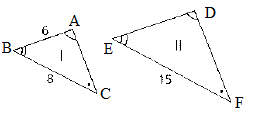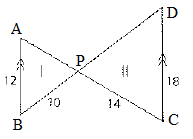
Concept explainers
a.
To find: the ratio of areas of two
a.
Answer to Problem 9PSB
The ratio of area I to area II is
Explanation of Solution
Given Information:
All the three
Measure of two sides of triangle I are
Measure of one side of triangle II is
Formula used:
Ratio of areas of two similar triangles is equal to ratio of squares of the corresponding sides.
Calculation:
Let the first triangle be

In
As we know that the ratio of areas of two similar triangles is equal to the ratio of squares of the corresponding sides.
Hence, ratio of area of triangle I to area of triangle II is
b.
To calculate: the ratio of area of triangle to area of rectangle
b.
Answer to Problem 9PSB
The ratio of area of triangle to area of rectangle is
Explanation of Solution
Given Information:
In triangle, base( b ) = 10 and height( h ) = 14.
In rectangle, length( l ) = 14 and breadth( b1 ) = 10
Formula used:
Area of a triangle
Area of a rectangle
Calculation:
In the triangle, we have b = 10 and h = 14
We know that, Area of a triangle
Now, in the rectangle we have, l = 14 and b1 = 10
We know that, Area of a rectangle
So, the ratio of area of I to area of II is given by
Hence, the ratio of area I to area II is
c.
To calculate: the ratio of areas of two triangles with same height.
c.
Answer to Problem 9PSB
The ratio of areas of two triangles with same height is
Explanation of Solution
Given Information:
In triangle I and triangle II, bases are equal and have same height.
Formula used:
Area of a triangle
Here,
Calculation:
Let triangle I be ABC and triangle II be ADE .
Let’s draw a perpendicular from A to BE intersecting it at F which act as the altitude or height for the big triangle and for the three small triangles.

BC = CD = DE … (Given)
We know that, Area of a triangle
Area of triangle I
Also, Area of triangle II
Hence, ratio of area I to area II is
d.
To calculate: the ratio of areas of two similar triangles when two sides of each triangle are given.
d.
Answer to Problem 9PSB
The ratio of areas of the given two similar triangles is 4:9.
Explanation of Solution
Given Information:
In the figure, the two opposite sides are parallel where the intersecting lines act as the transversals.
Formula used:
Ratio of areas of two similar triangles is equal to ratio of squares of the corresponding sides.
Calculation:
Let the two sides be AB and CD where AC and BD intersect at P .

As AB || CD and AC is the transversal, we have
As AB || CD and BD is the transversal, we have
Therefore, all three angles of
As we know that the ratio of areas of two similar triangles is equal to the ratio of squares of the corresponding sides.
Hence, ratio of area I to area II is
Chapter 11 Solutions
Geometry For Enjoyment And Challenge
Additional Math Textbook Solutions
Statistics for Business and Economics (13th Edition)
Basic Business Statistics, Student Value Edition (13th Edition)
A First Course in Probability
Probability and Statistics for Engineers and Scientists
Trigonometry (11th Edition)
A Problem Solving Approach To Mathematics For Elementary School Teachers (13th Edition)
 Elementary Geometry For College Students, 7eGeometryISBN:9781337614085Author:Alexander, Daniel C.; Koeberlein, Geralyn M.Publisher:Cengage,
Elementary Geometry For College Students, 7eGeometryISBN:9781337614085Author:Alexander, Daniel C.; Koeberlein, Geralyn M.Publisher:Cengage, Elementary Geometry for College StudentsGeometryISBN:9781285195698Author:Daniel C. Alexander, Geralyn M. KoeberleinPublisher:Cengage Learning
Elementary Geometry for College StudentsGeometryISBN:9781285195698Author:Daniel C. Alexander, Geralyn M. KoeberleinPublisher:Cengage Learning

